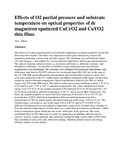| dc.description.abstract | The effects of oxygen partial pressure and substrate temperature on optical properties of and thin films have been studied. The films were deposited on float glass substrate by reactive DC magnetron sputtering system using and alloy targets. The sputtering was performed in Argon (Ar) and Oxygen ( ) atmosphere for varying substrate temperature and Oxygen partial pressure. The optical constants: refractive index, n, extinction coefficient, k, dielectric constant, , and absorption coefficient, , for and films at different oxygen partial pressure and substrate temperatures were determined. The constants were obtained from measured transmittance and reflectance data fitted in SCOUT software for wavelength range 200-2247 nm.
In the case of , the UV-VIS-NIR spectrophotometer measurements showed that films formed at various Po2 were non-transparent in the UV-visible region and highly transparent in IR region. For the films formed at various substrate temperatures optical transmittance achieved was 40% in visible region, and 70% in the NIR region. The optical studies gave energy band gap of about 2.47 eV at 0.153 bar Po2 and 3.7 eV at 263 °C substrate temperatures. The values obtained for Urbach energy were 0.27-0.31 eV for samples prepared at Po2 between 0.153-0.187 bar and 0.81-1.45 eV for those prepared at substrate temperature of 263 °C and as-grown film, respectively.
For films, the samples prepared at various Po2 had a band gap of between 4.32 to 4.41 eV and transmittance of 80%, while those deposited at different substrate temperature had a transmittance of 78% in visible region and optical band gap in the range 3.89 to 4.31 eV. The Urbach energy was found to vary in the range 0.99 to 0.45 eV and 0.871 to 0.697 eV for different O2 partial pressure and substrate temperature, respectively. In both cases (variation of Po2 and substrate temperatures) of films there was a rapid drop in extinction coefficient, , which leads to transparent region which prevails in the visible part of the spectrum.
The study established that CuCrO2 films may be useful for application in shielding infrared sensors, selective surface coating materials, anti-reflection coating for night vision while CuYO2 films find suitability in solar cells, anti- reflection coatings, shielding infrared sensor and energy efficient window in cold climate | en |

